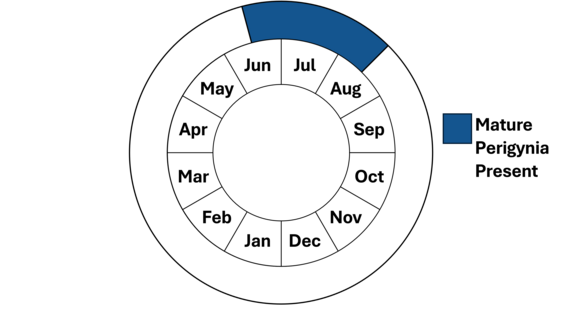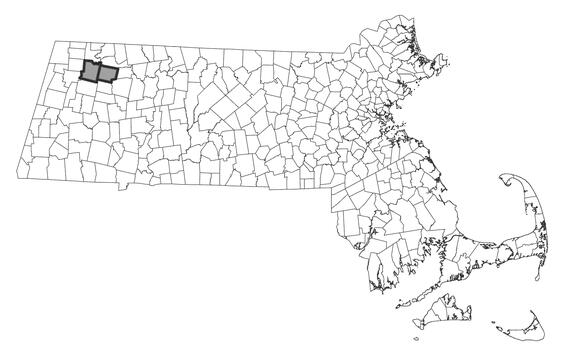- Scientific name: Carex michauxiana
- Species of Greatest Conservation Need (MA State Wildlife Action Plan)
- Endangered (MA Endangered Species Act)
Description
Michaux’s sedge is a perennial member of the sedge family (Cyperaceae) that occurs in boggy areas. It has narrow (1.5-4 mm; 0.06-0.16 in), yellowish green leaves that are shorter than the 15-70 cm (6-28 in) flowering stems. It is named for the French botanist and explorer André Michaux (1746-1802).
To identify Michaux’s sedge and other members of the genus Carex, a technical manual should be consulted. Species in this genus have tiny, wind-pollinated flowers that are borne in spikes. Michaux’s sedge is one of only two members of Carex section Rostrales found in New England. Species in this section have long, slender perigynia (8–15 mm [0.32-0.59 in] long and 1.5-3 mm [.06-.12 in] wide) that gradually taper to a beak with two erect to spreading teeth. The perigynia are borne on two to five stalked, lateral spikes, with the staminate flowers in a small terminal spike. Of these two species, Michaux’s sedge can be recognized by its smaller size, generally erect spikes, shorter pistillate scales, and upper leaf sheaths that are concave at the mouth.
The other member of Carex section Rostrales in New England is the common and widespread long-culmed sedge (C. folliculata), which can be found in similar wetland habitats. This species differs from Michaux’s sedge in its wider leaves (4-18 mm [0.16-0.71 in]), taller stems (up to 1.75 m [~5.7 ft]), and drooping lower spikes. Unusually small individuals of long-culmed sedge can be distinguished from Michaux’s sedge by the combination of pistillate scales that are more than two-thirds the length of the perigynia and upper leaf sheaths that are convex. Collins’ sedge (C. collinsii), which is rare in Connecticut and New York and has not been recorded from Massachusetts, also appears similar to Michaux’s sedge but has reflexed rather than spreading perigynia, with reflexed beak teeth.

Population status
Michaux’s sedge is listed under the Massachusetts Endangered Species Act as Endangered. All listed species are protected from killing, collecting, possessing, or sale, and from activities that would destroy habitat and thus directly or indirectly cause mortality or disrupt critical behaviors. MassWildlife’s Natural Heritage & Endangered Species Program database has 4 records from 3 counties: Berkshire, Franklin, and Hampshire. 3 of these records have been observed within the last 25 years.
Distribution and abundance
Michaux’s sedge occurs from Saskatchewan to Newfoundland, south to Minnesota and Maryland.

Distribution in Massachusetts
1999-2024
Based on records in the Natural Heritage Database
Habitat
The known sites for Michaux’s sedge in Massachusetts are boggy habitats with sphagnum. One population occurs along the margins of a sluggish stream and the pond that it feeds, with tawny cotton-grass (Eriophorum virginicum), threeway sedge (Dulichium arundinaceum), and several orchid species. The other is a shrubby wet meadow with shrubby cinquefoil (Dasiphora floribunda) and large cranberry (Vaccinium macrocarpon).
Healthy habitats are vital for supporting native wildlife and plants. Explore habitats and learn about conservation and restoration in Massachusetts.
Conservation
As for many rare species, exact management requirements for Michaux’s sedge are not known. Caution is needed at sites with extant populations to prevent disturbance of hydrological conditions. Management may be required at some sites to prevent establishment of dense woody vegetation that may shade or compete with Michaux’s sedge. All active management of rare plant populations (including invasive species removal) is subject to review under the Massachusetts Endangered Species Act and should be planned in close consultation with MassWildlife’s Natural Heritage & Endangered Species Program.
References
Gleason, H. A., and A. Cronquist. 1991. Manual of Vascular Plants of Northeastern United States and Adjacent Canada, 2nd edition. The New York Botanical Garden, Bronx, NY.
Haines, A. 2011. Flora Novae Angliae – a Manual for the Identification of Native and Naturalized Higher Vascular Plants of New England. New England Wildflower Society, Yale Univ. Press, New Haven, CT.
Contact
| Date published: | April 9, 2025 |
|---|